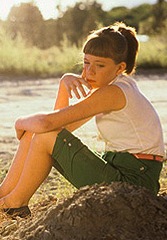November 7, 1985.
MY AMERICAN COUSIN. Written, co-produced and directed by Sandy Wilson. Running time: 91 minutes. Mature entertainment.
FROM THE MOMENT she sets eyes on him, she knows that her life will never be the same. Though she's only 12 — "I'll be 13 in three months. I'm practically a teenager!'' — Sandra Wilcox (Margaret Langrick) can feel the first stirrings of womanly passion.
O, unkind fate! Butch Walker (John Wildman), Sandy's worldly, 17-year-old California cousin, hardly knows she's alive. The first chance he gets, he's after Penticton's town beauty Shirley Darling (Camille Henderson).
"I wish I was dead," Sandy whines, diving into the cool waters of Okanagan Lake. "Well, maybe not completely dead," she says, surfacing again. "Just 16, and someplace else."
The moment the lights came up, I knew that this review was going to be a pleasure to write. Sandy Wilson's My American Cousin is as British Columbian as smoked salmon and Douglas firs.
A fine first feature from the Vancouver writer-director, it draws upon her own memories of an Okanagan adolescence to offer us the most satisfying teen comedy since American Graffiti.
Sandra Wilcox, Wilson's remembered self, lives with her family on the Paradise Ranch. It is 1959 and, as the film opens, she is confiding to her diary that "nothing ever happens."
That evening, a cherry-red Cadillac convertible pulls into the Wilcox yard. Sandy's second cousin Butch has come to visit, a denim-jacketed, duck-tailed rebel on the run.
It is a case of worlds in collision. Canadian respectability, represented by Sandy's firm but fair father John (Richard Donat) and Shirley's hard-working boyfriend Lenny (T.J. Scott), is affronted by Butch's brash, all-American rock-around-the-clock style.
Sandy, bored with childhood, finds the experience invigorating. At the Teen Town Dominion Day Dance, she dreams the impossible dream of running away with the fascinating foreigner.
Together with such Europeans as Francois Truffaut and Federico Fellini, Wilson shows us the exciting artistic possibilities in cinematic autobiography. In Sandra Wilcox, she creates a surrogate through whose eyes we see all the other characters.
Under Wilson's direction, debuting actress Langrick walks the fine line between precocity and vulnerability. She does so with unerring professionalism, allowing us to empathize with her and recognize that the somewhat stylized performances of her co-stars reflect the embellishments of a child's memory.
As photographed by Richard Leiterman, the colours of memory are as crisp and beautiful as the rural landscapes. Moods are cued with subtle precision by an artful selection of period pop tunes.
In My American Cousin, Sandy Wilson shows us a B.C. Interior that is every bit as interesting as the Australian film industry's outback. Her picture is among the year's best.
The above is a restored version of a Province review by Michael Walsh originally published in 1985. For additional information on this archived material, please visit my FAQ.
Afterword: The members of the Academy of Canadian Cinema shared my enthusiasm for Sandy Wilson's memoir, nominating My American Cousin for 11 Genie Awards. It won all the big ones, including best picture, best actress (Margaret Langrick) and best actor (John Wildman). Wilson took home a matched set (direction and screenplay), and entered the record books as the second woman to win a best direction Genie. (The first was Micheline Lanctot, whose win came one year earlier for the French-language feature Sonatine.) Langrick and Wildman reunited under Wilson's direction four years later for a sequel, American Boyfriends (1989), that picked up their story in the year 1965. Margaret Langrick pursued acting as a career for about 11 years, then set out in a new direction with a new name. Today, Maggie Langrick describes herself as "a writer, editor and media entrepreneur." After working in magazine and book publishing, she spent five years (2008-13) as the Vancouver Sun newspaper's Arts and Life editor. In 2013, she founded LifeTree Media, designed as a hybrid of traditional publishing and self-publishing services.
